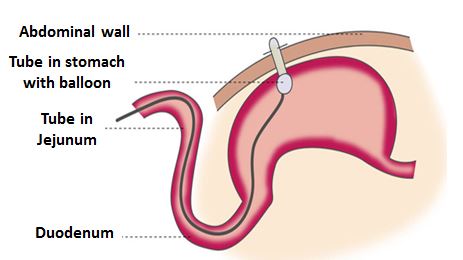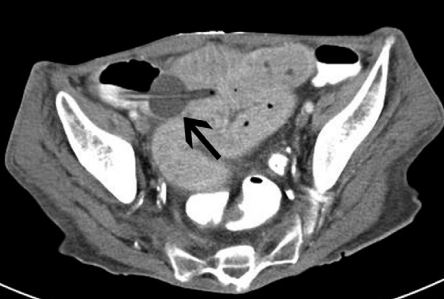A patient with progressive neurologic disorder had a gastrojejunal tube placed for feeding. In a nursing home, the tube fell out and was replaced with a Foley catheter. He was sent to the hospital for placement of a new tube. When he arrived in the interventional radiology suite, the Foley catheter was not visible. A new gastrojejunal tube was successfully placed, and the patient was sent back to the nursing home.
Below is a drawing showing where a gastrojejunal tube is placed.

He returned to the hospital two days later with a small bowel obstruction. A CT scan showed what was thought to be a retained portion of the original gastrojejunal tube. A surgeon was consulted but declined to operate on the patient because of his neurologic condition.
The patient was given IV fluids and antibiotics. Nonsurgical treatment of the bowel obstruction failed, and the patient died. According to the Agency for Healthcare Research and Quality on its Web Morbidity and Mortality section, a n autopsy showed the small bowel was obstructed by the Foley catheter balloon.
A root cause analysis identified a number of ways this death could have been prevented, including failure to appreciate that peristalsis could propel the Foley catheter into the small intestine. The catheter should have been secured to the skin with tape or sutures. The radiologist assumed the Foley catheter had been removed and did not think about it as a possible cause of the obstruction.
I can add that the consulting surgeon should also have known the Foley catheter could have been the problem. I am not sure why this patient, who had been suitable for placement of a feeding tube, was not considered a candidate for surgery.
Another reason obstruction by the catheter should have been considered is migration of a balloon-tipped catheter used as a feeding tube is not new. A Google Scholar search yielded numerous reports of similar cases dating as far back as the 1970s.
A 1991 paper in Gastrointestinal Endoscopy reported a similar case to the one above with x-ray findings showing the balloon obstructing the jejunum. In that instance, the tube passed into the colon and was retrieved using colonoscopy.
A 2009 case report described a gastrostomy tube that had migrated and caused a distal small bowel obstruction with the tube coiled in the right lower quadrant.

Using ultrasound the balloon was located in the ileum and manipulated up against the abdominal wall. A needle was used to puncture the balloon, and the patient passed the tube via the rectum two days later. This method might have prevented the death of the patient presented above.
Bowel obstruction by migration of a Foley catheter balloon is a well-documented event that is easily preventable. It should never happen. Will it happen again? Yes.
In 1905, George Santayana wrote, “Those who cannot remember the past are condemned to repeat it.”
“Skeptical Scalpel” is a surgeon who blogs at his self-titled site, Skeptical Scalpel. This article originally appeared in Physician’s Weekly.
Image credit: Shutterstock.com
Your patients are rating you online: How to respond. Manage your online reputation: A social media guide. Find out how.



